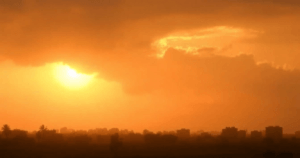India’s Summer 2025: 5 Major Reasons Heatwaves Will Impact 13 States – Expect Hotter Days!
The India Meteorological Department (IMD) has predicted that the summer of 2025 (April to June) will be hotter than usual, with both maximum and minimum temperatures expected to rise across the country. Many states, including Punjab, Rajasthan, Maharashtra, and Uttar Pradesh, are likely to experience 2-4 additional heatwave days compared to normal. The eastern region could face up to 10-11 heatwave days. This extreme heat poses significant health risks, especially for vulnerable groups like the elderly and children, and can strain infrastructure such as power grids.
The IMD also forecasts above-normal temperatures in most areas, except for some parts of south and northwest India. As for rainfall, the IMD will release its monsoon forecast in mid-April, factoring in various climatic conditions, including neutral El Niño conditions. These factors are expected to have minimal impact on the monsoon, though the situation remains fluid.

India’s Summer 2025: 5 Major Reasons Heatwaves Will Impact 13 States – Expect Hotter Days!
The India Meteorological Department (IMD) has warned that the upcoming summer months (April to June) are likely to be significantly hotter than usual across most parts of the country. Both daytime and nighttime temperatures are predicted to remain above normal, with a notable increase in heatwave days compared to previous years.
Regions at Higher Risk
States such as Punjab, Haryana, Rajasthan, Gujarat, Madhya Pradesh, Maharashtra, Uttar Pradesh, Bihar, Jharkhand, West Bengal, Odisha, Chhattisgarh, Telangana, Andhra Pradesh, and parts of northern Karnataka and Tamil Nadu are expected to experience 2-4 extra days of extreme heat during this period. Eastern India, including states like West Bengal, Odisha, and Jharkhand, could face the harshest conditions, with up to 10-11 days of severe heatwaves.
Health and Infrastructure Concerns
Heatwaves pose serious health risks, especially for vulnerable groups such as the elderly, children, and those with chronic illnesses like heart disease or diabetes. Prolonged exposure to high temperatures increases the risk of heat-related illnesses, including heat exhaustion (symptoms like dizziness, nausea, and fatigue) and life-threatening heatstroke (characterized by a sudden rise in body temperature and confusion). Health experts emphasize the importance of staying hydrated, avoiding direct sunlight during peak hours, and seeking cool environments.
Beyond health risks, extended periods of extreme heat also put pressure on infrastructure. Power grids face heightened demand due to increased use of cooling appliances, raising the risk of outages. Public transportation systems, especially railways, may also experience disruptions as tracks expand under intense heat. The IMD has urged state and local authorities to activate heat action plans promptly. These plans include setting up cooling centers, distributing water, and raising awareness about heat safety.
Temperature Predictions
Most regions will experience above-normal maximum temperatures this summer. However, parts of extreme southern India (like Tamil Nadu and Kerala) and some northwestern areas (such as Jammu and Kashmir) may see temperatures closer to their seasonal averages. Nighttime temperatures are also expected to remain elevated, reducing opportunities for natural cooling and increasing discomfort.
Monsoon Forecast on the Horizon
While the focus remains on the scorching summer, the IMD will release its first official monsoon forecast (June to September) in mid-April. This forecast will outline expected rainfall patterns, critical for agriculture and water resources. The prediction takes into account global climate factors like the El Niño-Southern Oscillation (ENSO), which influences weather worldwide.
Currently, ENSO conditions are neutral, meaning neither El Niño (linked to drier monsoons) nor La Niña (associated with heavier rains) is active. While neutral conditions suggest ENSO may not heavily impact this year’s monsoon, the IMD cautions that it’s too early to confirm trends. Long-range forecasts will be updated in May as more data becomes available.
Why the Monsoon Matters
India’s economy and food security rely heavily on the monsoon, which delivers nearly 75% of the country’s annual rainfall. A timely and balanced monsoon supports crops like rice, sugarcane, and cotton, while deficient rains can lead to water shortages and affect crop yields. Conversely, excessive rainfall may cause floods, damaging crops and infrastructure. Farmers, policymakers, and disaster management teams closely monitor these forecasts to prepare for potential challenges.
Staying Safe This Summer
Authorities advise the public to take precautions as temperatures rise:
- Stay Hydrated: Drink water regularly, even if not thirsty.
- Avoid Peak Heat: Limit outdoor activities between 12 PM and 4 PM.
- Use Protection: Wear lightweight clothing, hats, and sunscreen.
- Check on Vulnerable Groups: Ensure children, seniors, and those with health conditions have access to cool spaces.
- Recognize Warning Signs: Seek medical help if symptoms like headaches, rapid heartbeat, or fainting occur.
The IMD’s warnings highlight the growing challenge of extreme weather in India, urging communities and governments to prioritize adaptive measures. As climate patterns evolve, proactive planning and public awareness remain essential to mitigate risks to health, livelihoods, and infrastructure.
The next few months will test India’s preparedness for extreme heat, while the nation awaits clearer signals about the monsoon—a lifeline for millions.
You must be logged in to post a comment.